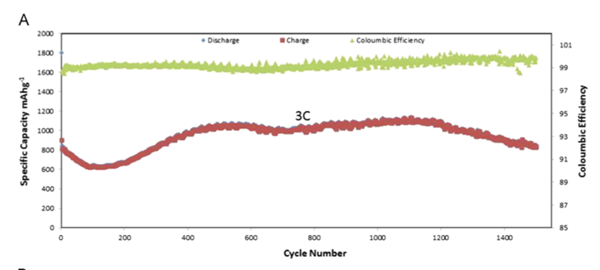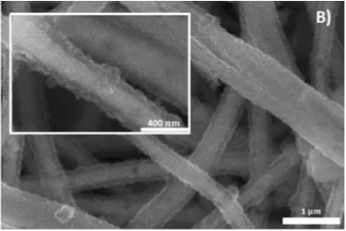Free-Standing Ni-Nio Nanofiber Cloth Anode For High Capacity And High Rate Li-Ion Batteries
Patent Status
| Country | Type | Number | Dated | Case |
| United States Of America | Issued Patent | 11,211,598 | 12/28/2021 | 2016-183 |
Full Description
Background
To meet market demand for cost effective, safe and high-performance Lithium-Ion batteries (LIB), researchers continue to pursue novel materials with varied nanostructures. LIB electrodes often consist of conductive additives, binder, current collector and active material. A free standing electrode incorporates the current collector into the electrode architecture thereby eliminating the need for binders or conductive additives. Replacements for graphitic anode include metals such as Silicon, Tin, other transitional metals and Lithium metal. Silicon, Tin and other transition metal oxides suffer from large volume expansions during charge/discharge causing degradation of the electrode. Nickel Oxide (NIO) is a promising candidate for anode but endures similar volume expansion limiting its potential.
Current Invention
Research team led by Profs. Cengiz and Mihrimah Ozkan, at UCR, have developed a patented and proven, Ni-NIO nanofiber cloth electrode that is synthesized by electrospinning and processed by simple heat treatments which addresses the challenges described above.

Deep Galvanostatic cycling data at 3C for more than 1000 cycles.

Scanning electron microscopy image of Ni-NIO fiber after 400 cycles at 3C.
Advantages
The benefits of their innovation and discovery are:
State Of Development
Lab level prototype built and tested.
The team fabricated 2032 type coin cells to test the performance of the Ni-NIO anodes. The results are impressive with a high capacity of 1108 mAh/gram after 1,500 cycles at a fast cycling rate of 3C and coulombic efficiency greater than 99%.
Suggested uses
- Lithium-ion battery anode
- Rechargeable energy storage
Related Materials
Contact
- Venkata S. Krishnamurty
- venkata.krishnamurty@ucr.edu
- tel: View Phone Number.
Other Information
Keywords
Ni-Nickel Oxide Anode, Nickel Oxide Nanofiber, Lithium-ion battery, Electrospinning, Rechargeable battery, Energy storage, Lithium Battery Anode
